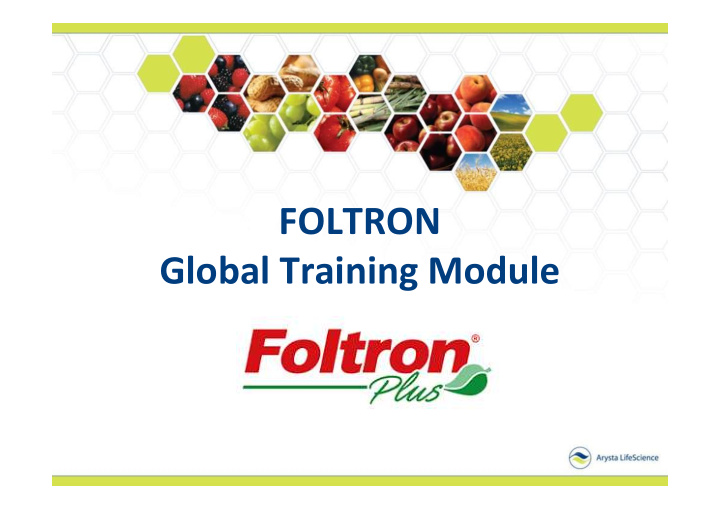



FOLTRON Global Training Module
Biostimulant to enhance vegetative growth 1. Presentation & Composition: - Liquid formula for foliar spray - Contents: • Folcisteine (0.275%) • Macronutrients: N (ammonium 5.6%); P (P2O5 19.5%); K (K2O 5.0%); Mg (0.01%) • Micronutrients: Mn (0.01%); Fe (0.05%); Zn (0.05%); B (0.008%); Cu (0.005%); Mo (0.0002%)
2. Mode of action: Folcisteine contained in Foltron slowly releases the Thiol groups (-SH) within the cell . S H • Thiols are highly reactive in enzymatic processes • Thiols regulate cell division and respiration • Thiols prevent oxidation of cellular compounds • Thiols are essential for metabolism of carbohydrates and proteins such as DNA, RNA & Ferrodoxin
2. Mode of action: Focus on antioxydant activity: Increasing of antioxydant in plants is signal of recovery from stress conditions. % Antioxydant activity in zucchhini plants after low temperature stress: 20.6 20 16.1 15 % 10 5 Research: ALS Mexico Laboratory 0 Control Foltron Folcisteine contained in Foltron induces more antioxydant activity, thus helping the plant recovery from abiotic stress condition.
2. Mode of action: Focus on Ferrodoxin role in chloroplasts: During photosynthesis, Ferrodoxin manages the distribution of energy to different plant physiological processes. Folcisteine contained in Foltron thus activates photosynthesis.
3. Crop benefits: Activates photosynthesis Enhances vegetative growth Helps plant recovery after abiotic stress Correct mineral deficiences
4. Grower benefits: Row crops : accelerates vegetative growth, leading to higher yield Fruiting crops : increases marketable yield, fruit size & quality Easy-to-use, compatible with most PPP and fertilizers
5. Crops & global recommendations: Crop Rate Timing (pepper, tomato, eggplant) 2-3 L/ha 1 st appl. at re-growth after transplanting; Solanaceous crops repeat every 2-3 weeks melons, watermelons etc.) 2-3 L/ha 1 st appl. re-growth after transplanting; Cucurbits (cucumber, repeat every 2 weeks 2-3 L/ha 1 st appl. at re-growth after transplanting; Brassicas (cabbage, broccoli, cauliflower) repeat every 2-3 weeks 2-3 L/ha 1 st appl. at re-growth after transplanting; Leafy crops (salads, tobacco, leguminosis) repeat every 10 days 2-3 L/ha 1 st appl. at beginning of tillering (BBCH 21-23) Cereals 2 nd appl. at flag leaf stage (BBCH 37) 2-3 L/ha 1 st appl. at tillering; 2 nd appl. at flag leaf stage Rice Maize & Sorghum 2-3 L/ha At 4-8 leaves stage 2-3 L/ha 1 st appl. at stem elongation; repeat after 2 weeks Oilseed rape 2-3 L/ha 1 st appl. at 10-15 cm plant height; repeat every 2-3 weeks Potato 2-3 L/ha 1 st appl. before flowerbud setting; repeat every 2-3 weeks Cotton
6. Technical data summary: % Yield increase in ROW CROPS: Rice Corn Wheat + 18 to 24% + 2 to 17% + 5 to 10% 4 trials Thailand 9 trials China, Africa, Chile 3 trials Brazil, 1 appl. 1 L/ha 1-2 appl. 1 to 2 L/ha Argentina, Chile 1-2 appl. 0.5 to 2 L/ha Soybean Sugarcane Grass + 7 to 79% + 9 to 34% + 5 to 50% 3 trials Chile, Brazil 4 trials Argentina, Chile 3 trials Brazil, Argentina 1-2 appl. 0.5 to 3 L/ha 1 appl. 2 to 3 L/ha 1-2 appl. 1 to 2.5 L/ha
6. Technical data summary: % Marketable yield increase in FRUITING & LEAFY VEGETABLES: Tomato Cucumber Melons + 8 to 69% + 7% + 9 to 76% 13 trials Europe, 1 trial Poland +1.5 to 2.4 points of Brix Chile,China, Africa 3 to 4 appl. 2 L/ha 4 trials Africa, Mexico, Guatemala 2 to 6 appl. 2 to 3 L/ha 3 appl. 2 to 3 L/ha Lettuce Cabbage + 12 to 16% + 10 to 13% +12 to 17% plant weight 4 trials Europe 3 trials Europe 2 appl. 2 to 3 L/ha 2 appl. 2 to 3 L/ha
6. Technical data summary: % Marketable yield increase in FRUIT TREES: Apple Peach Cherry + 5 to 27% + 29 to 44% + 20% bud growth Argentina trial Argentina trial Chile trial 4 appl. 1.5 to 4 L/ha 4 appl. 2 to 4 L/ha 3 appl. 3 L/ha Citrus Coffee + 11 to 34% + 9 to 10% Brazil trial China trial 1-2 appl. 1 to 3 L/ha 2 appl. 1.8 L/ha
6. Technical data summary: Effect on GRAPES & ORNAMENTALS: Table grape Wine grape Rose + 5 to 9% growth rate + 36% Leaf area + 24 to 50% 2 trials Chile Ecuador trial French trial 2 appl. 1 cc/L 2-3 appl. 1.2 to 3 L/ha 2 appl. 3 L/ha
Annex: Other Information & Recommendations STABILITY Under normal temperature and humidity, FOLTRON is preserved without change in physicochemical characteristics for at least two years. During periods of extended storage, shake the bottle well before use. COMPATIBILITY FOLTRON is compatible with most insecticides, fungicides, herbicides and fertilizers of agricultural use. It does not produce plant toxicity when used at the recommended rates. PHYSICAL PROPERTIES Appearance and odour Dark brown liquid Solubility in water Miscible Vapour pressure (mm of Hg) 17.5 Boiling point (°C) 104°C pH (10% dilution) 5.3 - 6.5 Relative density 1.25 - 1.3
Recommend
More recommend